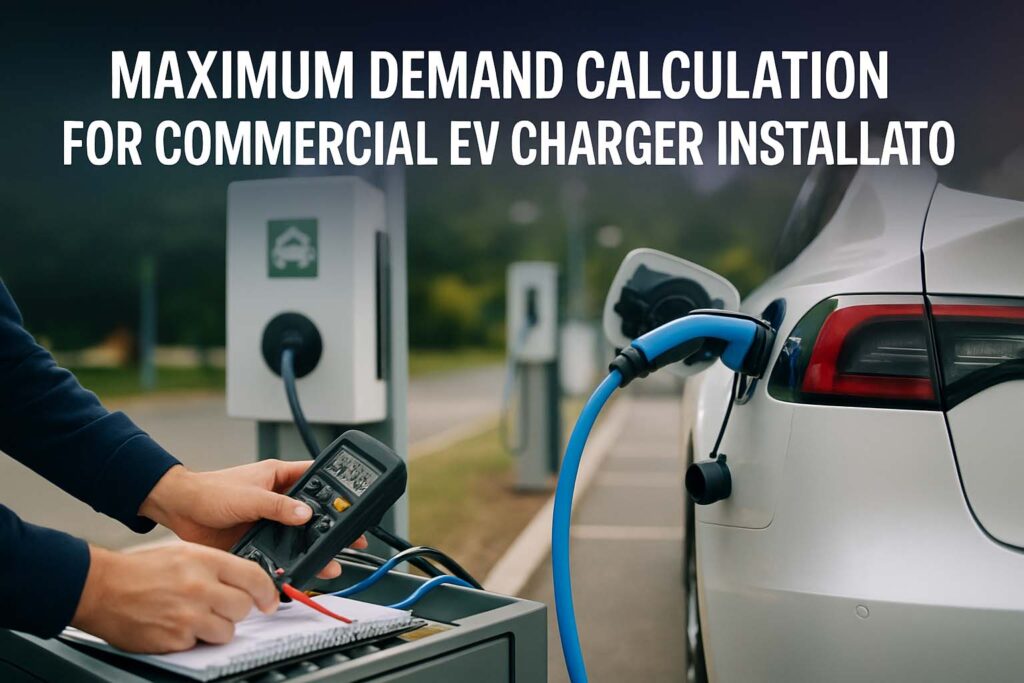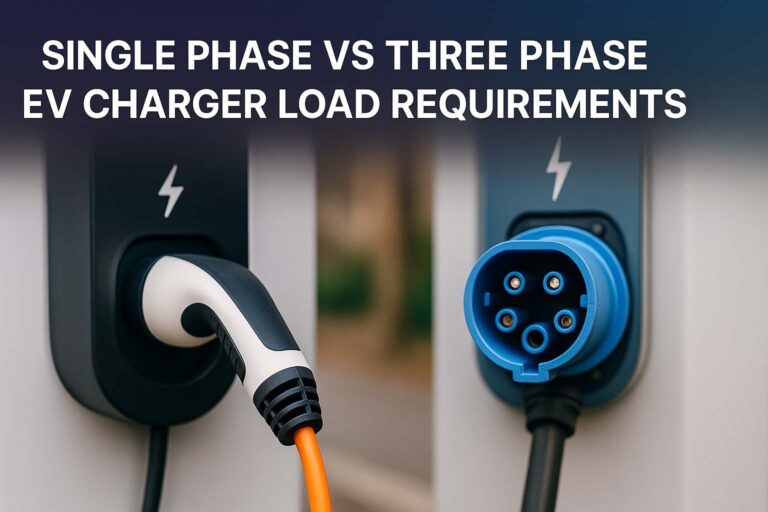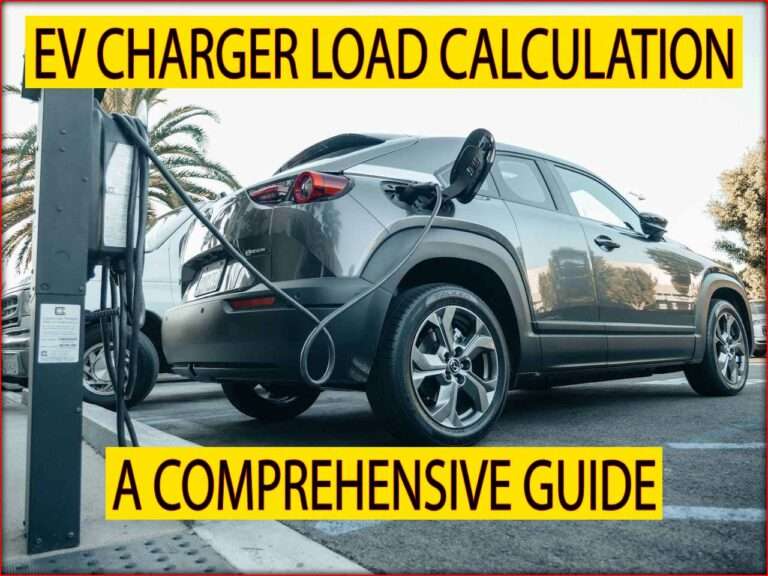Maximum Demand Calculation for Commercial EV Charger Installations
Understanding EV Charging Maximum Demand
Electric Vehicle (EV) charging is becoming mainstream across Europe. Commercial sites such as office buildings, shopping centers, and fleet depots are investing heavily in EV infrastructure. However, the sudden increase in electricity consumption due to multiple chargers can cause major stress on the grid if not properly planned.

That’s where EV charging maximum demand calculations come into play.
In simple terms, maximum demand is the highest level of electrical power drawn from the supply at any given time. When designing a commercial EV charging station, this peak demand must be predicted with accuracy. It ensures that the main power supply, transformer, and protection equipment are sized correctly.
Key Takeaways:
- Calculating EV charging maximum demand is crucial to avoid overloading supply systems.
- Commercial EV load calculation must account for charger types, diversity factors, and future growth.
- Load diversity is especially important in Europe due to varying usage patterns and building codes.
- This guide explains the step-by-step process for maximum demand calculation with real-world examples.
Why Commercial EV Load Calculation Matters
When you install a single 22 kW EV charger, it may not create a significant load issue. But when you install 10, 20, or even 50 chargers in a commercial setting, the game changes.
Let’s look at the potential load of 20 chargers:
| Charger Type | Power per Unit (kW) | No. of Chargers | Total Load (kW) |
|---|---|---|---|
| AC Type 2 | 22 kW | 20 | 440 kW |
Without considering diversity or smart control, you may need to size your electrical infrastructure to handle 440 kW of continuous load. That’s costly, inefficient, and often unnecessary.
Know more about Single Phase vs Three Phase EV Charger
Factors Affecting EV Charging Maximum Demand
- Charger Type
- AC chargers (7kW–22kW)
- DC fast chargers (50kW–350kW)
- Simultaneous Usage
All chargers are not used at the same time. This is where the diversity factor comes in. - Smart Load Management
Load balancing software can limit the simultaneous demand across multiple chargers. - Operating Hours
EV charging patterns vary — office hours, overnight, or 24/7 operations. - Fleet or Public Use
Fleet chargers may have predictable usage. Public stations are more random.
Step-by-Step Guide to Commercial EV Load Calculation
Step 1: Determine Individual Charger Ratings
List out all chargers with their rated power:
| Charger No. | Type | Power (kW) |
|---|---|---|
| 1–10 | AC | 22 kW |
| 11–15 | DC | 50 kW |
Total Raw Load = (10 × 22) + (5 × 50) = 220 + 250 = 470 kW
Know more about How to Calculate Load for Multiple EV Chargers in Apartment Buildings
Step 2: Apply Diversity Factor
A diversity factor accounts for the probability that not all chargers will run at full load simultaneously. It is especially relevant for commercial sites in Europe, where regulations often assume diversified usage.
Common diversity factors range from 0.4 to 0.8 depending on:
- Site usage pattern
- User behavior
- Smart load management systems
Let’s assume a factor of 0.6:
Maximum Demand = 470 kW × 0.6 = 282 kW
This is a much more realistic value for infrastructure planning.
Step 3: Consider Power Factor and Amperage
To size transformers and breakers, convert the maximum demand into amperes:
Formula:
Current (A) = (Power (kW) × 1000) / (√3 × Voltage × Power Factor)
Assume:
- Voltage = 400V
- Power Factor = 0.95
Then:
I = (282,000) / (1.732 × 400 × 0.95) = ~429 A
You need cables, breakers, and possibly a transformer that can support ~429 A continuously.
Know more about 7kW EV Charger Cost: A Detailed Guide
Diversified Load Considerations in Europe
In many European countries, diversified load Europe guidelines are issued by grid operators. For example:
- Germany (VDE-AR-N 4100) encourages dynamic load control.
- UK (ENA Engineering Recommendation G99) suggests 0.6–0.7 diversity for fleet and public chargers.
- France (ENEDIS) applies a standard 0.5 factor for workplace charging.
Best Practices for European Installations
- Consult with your DSO (Distribution System Operator)
- Align with IEC 61851 and IEC 60364-7-722 standards
- Use real-world charging data where available
Real-World Example: Office Building in Amsterdam
Scenario:
A tech company installs 30 EV chargers at its headquarters:
- 20 x 22 kW AC
- 10 x 50 kW DC
- Smart load management system installed
Step 1: Total Load
= (20 × 22) + (10 × 50) = 440 + 500 = 940 kW
Step 2: Diversity Factor
= 940 kW × 0.55 = 517 kW
Step 3: Add Future Buffer (20%)
= 517 + 20% = 620 kW
This value is then used to size:
- 800 kVA transformer
- 1000 A main panel
- 600 A feeder cables
This approach prevents under or over-sizing and aligns with Dutch energy efficiency laws.
Know more about Portable EV Charger Level 2
Smart Load Management vs Maximum Demand
Smart charging systems can flatten the demand curve. Rather than allowing all EVs to charge at once, the software spreads the load:
- Priority to vehicles with low battery
- Dynamic throttling during peak utility hours
- Integration with solar or battery storage
With this, the EV charging maximum demand can drop further — even below the 0.5 diversity factor threshold.
Transformer and Infrastructure Sizing Based on EV Load
Here’s a reference table to size transformers based on diversified EV loads:
| Max Demand (kW) | Recommended Transformer (kVA) |
|---|---|
| Up to 100 kW | 125 kVA |
| 100–200 kW | 250 kVA |
| 200–400 kW | 500 kVA |
| 400–600 kW | 800 kVA |
| 600–800 kW | 1000 kVA |
Always include:
- Safety margin of 10–20%
- Consideration of non-EV building loads
- Peak/off-peak load management strategies
Know more about Best Portable EV Charger
Mistakes to Avoid in Commercial EV Load Planning
- Ignoring Diversity Factor
Leads to oversized transformers and wasted capital. - Not Considering Site-Specific Behavior
Fleet depots behave differently from shopping malls. - Forgetting Future-Proofing
Always account for 10–30% increase in EV usage in next 5 years. - Overlooking Grid Constraints
Your DSO may limit your peak draw—factor it in. - Not Using Real-World Usage Data
Data logging for a few months helps optimize future expansions.
Conclusion: The Right Way to Calculate EV Charging Maximum Demand
Commercial EV charging is about more than just plugging in chargers. You need to understand commercial EV load calculation, smart control, and diversified load Europe standards to make your system cost-effective and compliant.
Accurate EV charging maximum demand calculations ensure that your investment in EV infrastructure delivers ROI, reliability, and regulatory compliance.
Follow Us on Social:
Subscribe our Newsletter on Electrical Insights to get the latest updates in Electrical Engineering.
#EVCharger, #MaximumDemand, #CommercialEV, #EVLoadCalculation, #ElectricVehicleCharging, #EVInfrastructure, #SmartCharging, #EnergyManagement, #EVChargingEurope, #SustainableTransport, #LoadDiversification, #PowerDemand, #EVInstallation, #EVSE, #ElectricalEngineering



![Best EV Chargers for Hotels & Guest Accommodations [Commercial Grade] 4 Best EV Chargers for Hotels & Guest Accommodations [Commercial Grade]](https://azadtechhub.com/wp-content/uploads/2025/10/Best-EV-Chargers-for-Hotels-Guest-Accommodations-Commercial-Grade-768x512.jpg)


